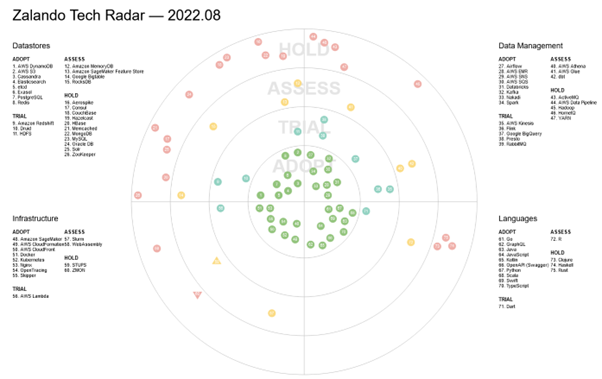“Every company is a software company,” or a data company or a technology company. This phrase – first uttered over a decade ago in the nascent years of ecommerce, cloud services and social media – speaks to the all-encompassing impact of technology on an organisation’s ability to operate and compete. Transforming into a large scale, data driven, high automated, highly connected and agile business is an incredibly complex and difficult undertaking. It takes a completely different mindset, skill base and organisational structure, supported by a continuously evolving technical infrastructure. Most retailers have struggled through this transformation. Some have had great success emerging as start-ups with a fundamentally technical core, leapfrogging the competition. Think Amazon and Zalando. Here, we look at one of the practices that have empowered Zalando’s success and continues to shape their vision: the Tech Radar.
What is a Tech Radar?
A Tech Radar maps the current and future direction of technology adoption in an organisation. It helps build and evaluate a technology portfolio that will inform management, strategic planning on future projects and the larger direction of the company.
A Tech Radar visually casts technologies and techniques as ‘blips’ on a circular web, indicating their status and relevance within the company’s technical landscape. These blips can represent not just technologies but also platforms, tools, patterns, frameworks and programming languages that are relevant to your industry and culture.
Originally pioneered by Thoughtworks, there are several variations on the Tech Radar depending on your scope and objectives. Thoughtworks themselves use it to evaluate technologies and practices more broadly across different organisations. Zalando’s own Tech Radar (above) has four separate technical quadrants: Datastores, Data Management, Infrastructure and (Programming) Languages. The Radar is ringed into four assessment statuses representing where in the adoption cycle the technology stands: Hold, Assess, Trial and Adopt.
Zalando define their rings as follows:
- ADOPT: technologies with broad adoption, in which the company is willing to invest long-term
- TRIAL: captures all current experiments in production
- ASSESS: active, non-production assessments of promising technologies and trends
- HOLD: discouraged from broad adoption where the company is not willing to invest further; no new applications may use this technology
Zalando’s Tech Radar gives a good overview of the core technical components behind their business, their engineering skillsets, and their progression towards more advanced cloud services. It’s a powerful perspective of their engineering practices. And as a general framework, it can also be complemented with overlays, filters, colour coding, and iconography to attain different views of the Radar depending on the perspective.
Benefits of a Tech Radar
With change occurring at such an unrelenting pace, we constantly need the oversight of a technological ecosystem that enables proactive and reactive progress. With cloud services and platforms, new technologies have become increasingly easier to adopt. Yet the burden of integrating the technology, processes and knowledge means we still need to be thoughtful with our approach.
Within fashion retail, Zalando are a very tech savvy company, with strong internal development teams capable of building custom applications and infrastructure. Your own organisation may be a more hybrid mix of internal infrastructure and third-party, proprietary systems. The Tech Radar helps you position all these technologies within the framework and make important strategic decisions on how to align them towards your objectives.
Benefits of the Tech Radar include:
- Map internal systems and skillsets from which to plan future projects and infer strengths and weaknesses, opportunities and risks.
- Generate awareness and share knowledge and experience of technologies. Align on good engineering practices.
- Analyse technology decisions and assess holistic impacts.
- Track technology adoption and readiness.
- Understand how all the various technologies are connected and support/hinder each other.
- Determine what you can build in-house vs. what you should out-source. Aid in vendor selection.
- An early warning platform to identify technologies and techniques that can serve as threats or opportunities. Identify the technology trends that competitors and start-ups are using or considering and the potential advantages.
How to Implement a Tech Radar
A Tech Radar can start life simply as a diagram within your presentation software and updated quarterly, or more depending on your technology adoption rate. Alternatively, Zalando’s Tech Radar is an open-source web file (HTML, JS) that can be recreated on your own site or internal network. In any case, your Tech Radar should be presentable, accessible, and amendable.
Zalando’s four quadrants represent key structural elements of a modern tech stack and are a good starting point, but you may wish to restructure these quadrants based on your own infrastructure and technology decisions.
Start filling in your Radar starting with the inner most ring of technologies you have or will adopt. Many of the technologies will hopefully be easy to identify within your organisation. Some, such as languages, may require a survey. Work your way towards the outer rings by analysing and discussing future projects that the company are looking to engage in and the technologies or capabilities that are required to fulfill them. It may also be worth considering longer term projections and evaluating your position and capabilities against similar companies or market leaders.
There should be an owner, often the Lead/Principal Engineers or CTO, who maintains the Radar and facilitates regular discussion around technology review and selection. The Tech Radar should be open for all Engineering teams to contribute to, with proposals and status changes discussed and voted on. When working your way from ‘Assess’ to ‘Adopt’, a clearly outlined approach and criteria for evaluating technologies can be very helpful in gauging viability, effectiveness and long-term value and avoiding conflicts.
Whilst it is often easy to identify the gains of a new technology, it’s often harder to spot the challenges. These might include increased maintenance and code/process duplication, reduced cross-team collaboration, less integrated tooling, and generally a greater complexity overhead. Effective technology adoption is often targeted at specialised use cases or those that bring a paradigm shift aligned with business value and product fit.
 AUTHOR – Nam Nguyen, Technical Consultant , Change Management Group (CMG)
AUTHOR – Nam Nguyen, Technical Consultant , Change Management Group (CMG)
For help establishing your own Tech Radar:
References:
https://opensource.zalando.com/tech-radar/
https://www.thoughtworks.com/radar





